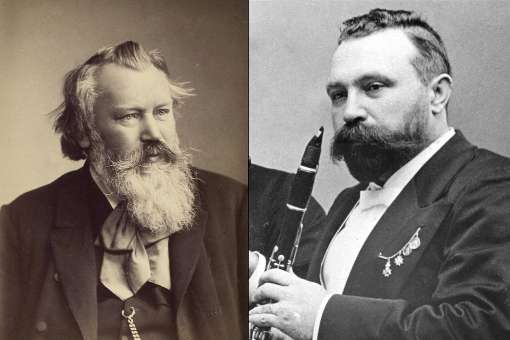Fräulein Klarinette. Meine Prima donna. The nightingale of the orchestra. Just three of the nicknames by which Johannes Brahms referred to Richard Mühlfeld, clarinettist of the Meiningen Orchestra, the player whose sound Brahms so adored and who tempted him out of self-imposed retirement for a compositional Indian summer during which he wrote four of the greatest works in the instrument's chamber repertoire.

Born in 1856, Mühlfeld had originally joined the Meiningen Court Orchestra as a violinist but switched to the clarinet a few years later. Apart from a little instruction from his father, Mühlfeld was largely self-taught but swiftly became the Meiningen principal. In the 1880s he also played principal clarinet in the Bayreuth Festival Orchestra, where Wagner was so impressed that he told him, “Young friend, continue this way and the whole world is open to you.”
It was in 1890, after composing his String Quintet no. 2 in G major, that Brahms signalled his intention of calling it a day. But then in March 1891 he heard Mühlfeld play Weber's Clarinet Concerto no. 1 in F minor and Mozart's Clarinet Quintet in A major and Brahms' resolve evaporated. What was it about Mühlfeld's playing that so seduced Brahms? His instrument was almost certainly a key factor. Mühlfeld played a Müller-system clarinet, constructed with 18 keys, made in Munich by Georg Ottensteiner, the same type owned by Carl Baermann (the son of Weber's muse), patented in 1850. We know that Mühlfeld had a thin metal strip attached to the mouthpiece (to cushion his top teeth) and that he preferred to tie his reeds to the mouthpiece rather than use a metal ligature. Perhaps it was harder to play fast, technical passages on Mühlfeld's clarinet than on the modern instruments of the period, but it could negotiate jumps between registers more elegantly and his sweeter, old-fashioned sound could well explain Brahms' feminine sobriquets with which this article opened.
“Nobody can blow the clarinet more beautifully than Herr Mühlfeld of this place,” Brahms wrote to Clara Schumann. “The clarinet players in Vienna and many other places are quite fairly good in orchestra, but solo they give one no real pleasure.” Brahms and Mühlfeld soon became great friends, like Mozart and Anton Stadler a century before them. Where Mozart and Stadler's friendship yielded a concerto and a clarinet quintet, Brahms and Mühlfeld's resulted in a quartet of chamber masterpieces.
The Clarinet Trio and Clarinet Quintet were both composed at Brahms' summer retreat at Bad Ischl in 1891. The Trio was written for the unusual combination of clarinet, cello and piano (Carl Frühling was to follow Brahms’ model ten years later). Its pervading mood is introspective and sombre. The second movement, in particular, accentuates the different registers – clarino and chalumeau – which Mühlfeld’s clarinet could essay. The Andantino grazioso plays on the instrument’s wistful quality, and while the fourth movement opens in more forceful, dramatic style, lyrical lines are never far below the surface.
Brahms’ Clarinet Quintet shares certain stylistic qualities with Mozart’s. Both begin with strings alone, the clarinet entering with an ascending arpeggio. Strings play muted in both slow movements. Each references folk music – the gypsy episode in Brahms’ Adagio suggesting he could have been inspired by hearing Hungarian gypsy ensembles where the clarinet would take the lead. Both quintets end with finales featuring a series of variations. Brahms’ Clarinet Quintet is an undisputed masterpiece, mellow in tone, displaying the clarinet’s lyrical qualities and its rhapsodic capabilities. The very opening is autumnal and nostalgic, tinged with regrets and what-might-have-beens. Was Brahms thinking of Clara Schumann here?
The Quintet was premiered – like the Trio – on 24th November 1891, Mühlfeld playing with the Joachim Quartet. Joseph Joachim – another Brahms muse – praised the clarinettist highly. “Mühlfeld, with his superb-tone Ottensteiner clarinets and string-like style of playing, and the Quartet, each possessing a Stradivarius of the very best period, produced a homogeneity of sound which can well be imagined.”
Legend has it that the first edition of Brahms’ two Clarinet Sonatas described them as “for piano and Mühlfeld” rather than “for piano and clarinet”, which is a lovely acknowledgement on the part of the composer. The opening of the F minor sonata features huge acrobatic leaps for the clarinet, while the finale is a lively rondo. The two inner movements have great lyrical qualities, especially the A flat major second movement Andante un poco adagio with its longing sighs.
The Clarinet Sonata no. 2 in E flat major is one of the glories of the instrument’s repertoire. Its opening movement glows with gentle warmth, requiring feathery fingers. The Appassionata is like a scherzo – or perhaps a Hungarian Dance – with its impetuous feel, although the trio section sings out, often in the low chalumeau register. The finale sets off reflectively, until spurring itself into something more upbeat in the last two minutes, to provide an optimistic close. Apparently, Mühlfeld’s clarinet had a very narrow range of tonal adjustment – pulling the mouthpiece out to flatten the sound – and when preparing to perform the sonatas for Clara Schumann, Mühlfeld sent his tuning fork so that her grand piano could be adjusted instead!
Nevertheless, Clara was full of praise, writing to Brahms in March, 1894, "This man plays so wonderfully, he might have been specially created for your works. I marvelled at his profound simplicity and the subtlety of his understanding." Later that year, she declared, “We should set this clarinet player in gold.” In appreciation, Brahms gave Mühlfeld a set of fine silver teaspoons with a monogram inscribed to him.
It was not long after touring their four clarinet compositions that Brahms' health deteriorated. Mühlfeld saw Brahms for the last time on 25th March 1897 when they dined together. The composer died nine days later, succumbing to liver cancer. The last time Brahms heard Mühlfeld, it was not one of his own works, but Weber's Clarinet Quintet, allowing him to savour his “nightingale” warbling for the final time.
This article was updated to correct details about Mühlfeld's clarinet, Many thanks to Emily Worthington for the information.


